Introduction
- Topic:
- Enhanced Thinking Skills (ETS) from England and Choosing to Think, Thinking to Choose (CTTC) from Philadelphia, PA.
- Outline:
- Overview and Sociocultural Perspectives.
- Effectiveness.
- Comparisons/Suggestions for Improvement.
This presentation is dedicated to the analysis and comparison of two reentry programs: the Enhanced Thinking Skills (ETS) curriculum that is used in England, UK and Choosing to Think, Thinking to Choose (CTTC), which is employed in Philadelphia, PA. The presentation will offer their overview, demonstrate the data which evidences their effectiveness, and suggest a comparison with some notes about potential improvements.

ETS: Overview, Sociocultural Perspectives
Travers, Wakeling, Mann, and Hollin (2013); National Institute of Justice (2017):
- Cognitive–behavioral skills; 20 2-hour sessions.
- Population: medium/high-risk offenders, 18+, male and female, any ethnicity.
- Sociocultural context:
- The importance of cognitive-behavioral skills for reentry; the issues that can lead to their deficiency.
- No cultural customization.
As described by Travers et al. (2013) and the National Institute of Justice (2017), ETS is a program that aims to develop cognitive-behavioral skills in medium-to-high-risk adult offenders of any gender and ethnicity. To this end, ETS uses a series of 2-hour sessions delivered by the prison staff. The program is based on the idea that cognitive-behavioral skills are necessary for reentry and acknowledges the fact that a variety of socioeconomic and sociocultural factors can hinder their development. However, the program does not appear to have any specific cultural dimensions, which can be viewed as a limitation.
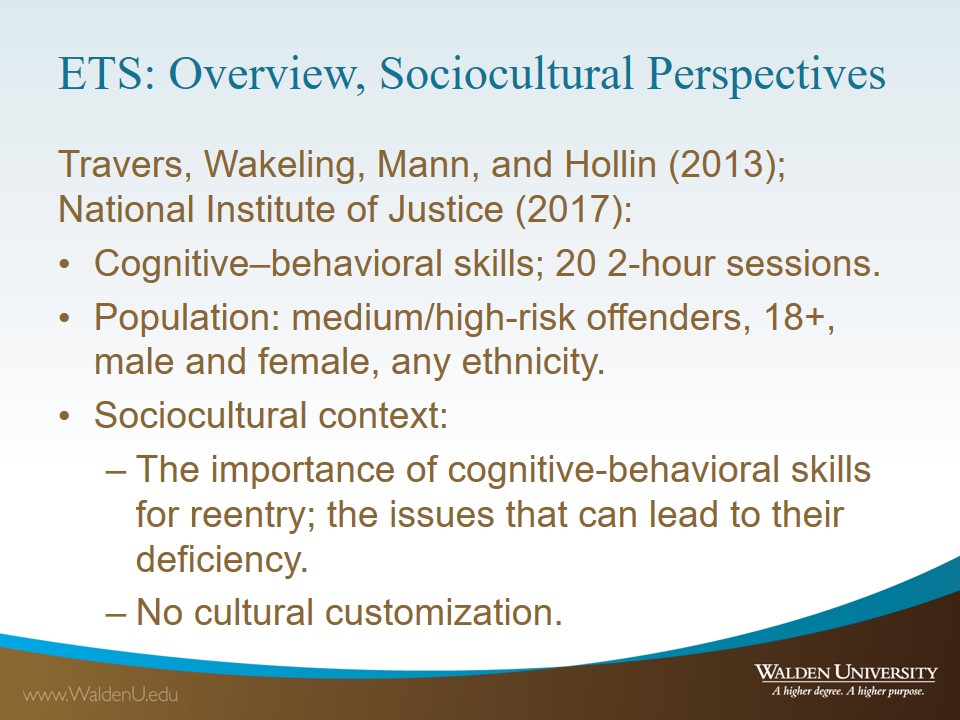
CTTC: Overview, Sociocultural Perspectives
Barnes, Hyatt, and Sherman (2016); National Institute of Justice (2018a):
- Cognitive-behavioral therapy; 14 2-hour sessions.
- Population: high-risk, male,18+, Black and other.
- Sociocultural context:
- Takes into account the importance of social skills for reentry.
- Customized for Black males.
According to Barnes et al. (2016) and the National Institute of Justice (2018a), CTTC is based on cognitive-behavioral therapy (CBT) and includes 14 two-hour-long sessions that are delivered by prison staff to high-risk male adult prisoners. The program is mostly focused on Black people, but other races and ethnicities are also eligible. From the sociocultural perspective, the program is somewhat geared towards a specific ethnicity, which implies a form of cultural customization. However, the found materials on CTTC do not focus on the way this customization is achieved. Also, the program recognizes the significance of social skills for reentry and, as a result, focuses on them.
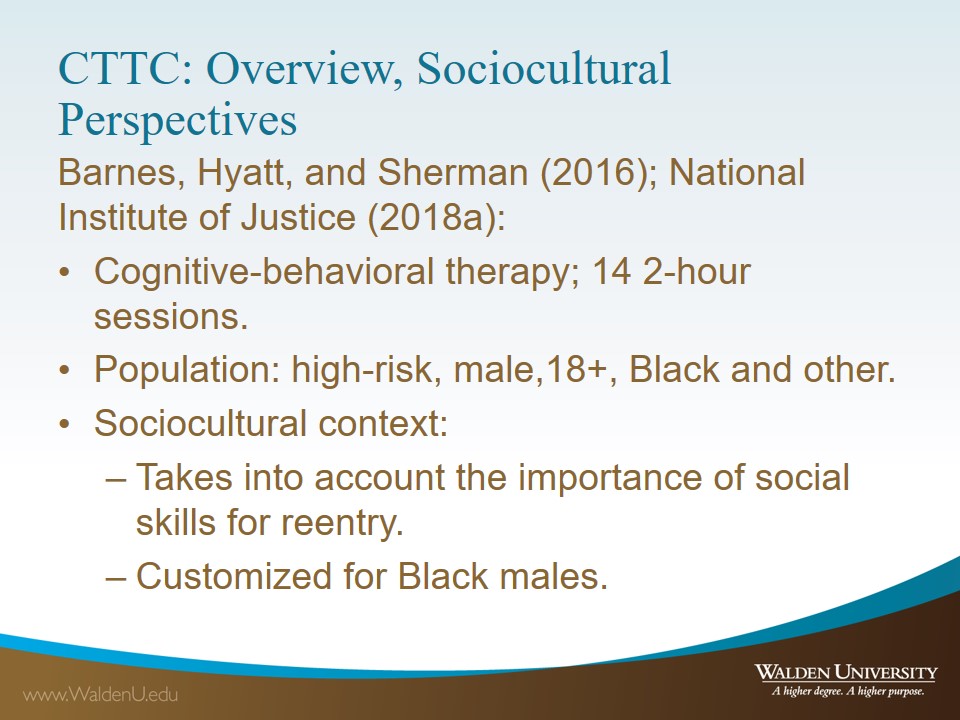
ETS Effectiveness
The National Institute of Justice (2017) notes that there are at least three relevant studies which investigate ETS and its effectiveness. It should be noted that there is a randomized controlled trial which is dated 2003. It demonstrated the effectiveness of ETS in reducing reconviction rates. However, the source is very outdated, which is why it is not present here. Newer ones will be discussed. Fig. 1 demonstrates that the report commissioned by the British Ministry of Justice found a statistically significant reduction of reconviction rates in the treatment group of ETS. However, the author notes that without the people who dropped out of the program, the reduction is slightly smaller and may lose statistical significance (Sadlier, 2010).
For reoffending, the picture is the same as can be seen in fig. 2: the frequency of reoffending was reduced in the treatment group (Sadlier, 2010). However, this figure does not depend on the drop-out rate. It should be noted that the report focused on 257 participants who took part in ETS; the control sample was thoroughly matched. Overall, the methodology of the report seems to make its results reliable, but it tracked the participants for one year only.
A more recent study by Travers et al. (2013) was focused on a larger sample (17,047 participants in the treatment group) for two years, but it also studied an earlier period (between 2000 and 2005). Additionally, it compared the treatment group to an automatically generated sample of 19,792 people. Only males were eligible for the study, and it was found that ETS resulted in a significant reduction in reoffending, especially when longer sentences were concerned. Thus, two recent studies on ETS suggest that it is effective. See fig. 3 for illustration.
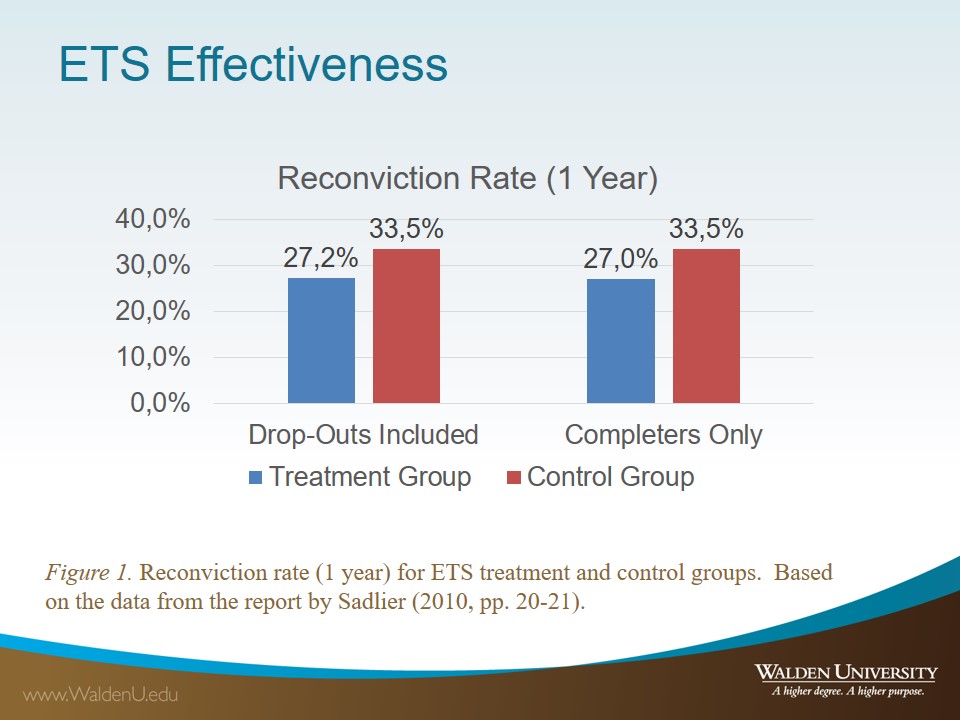
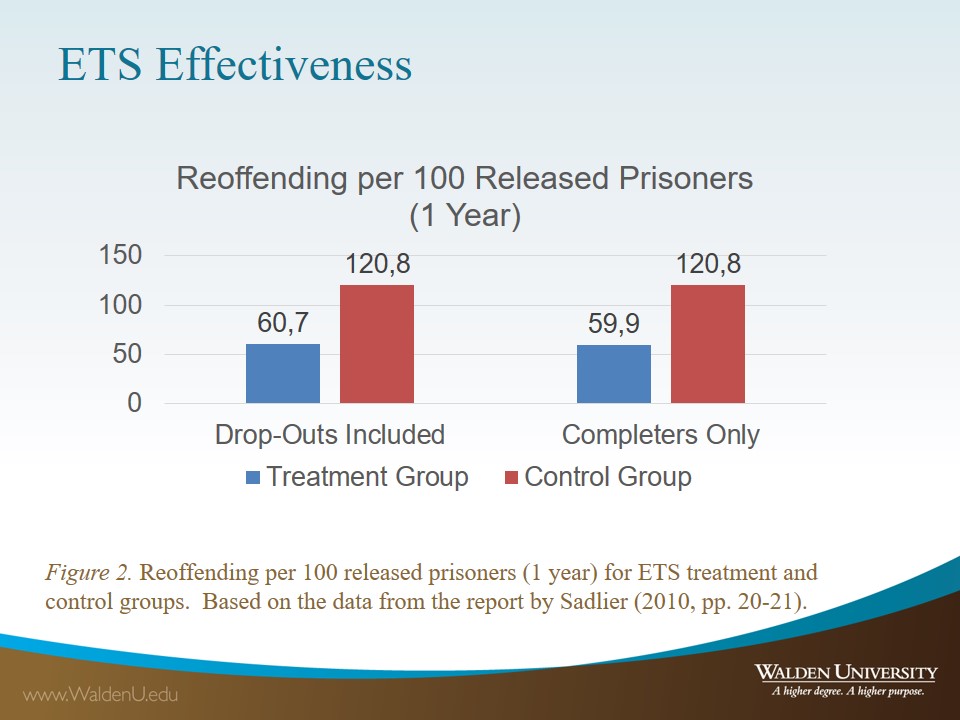
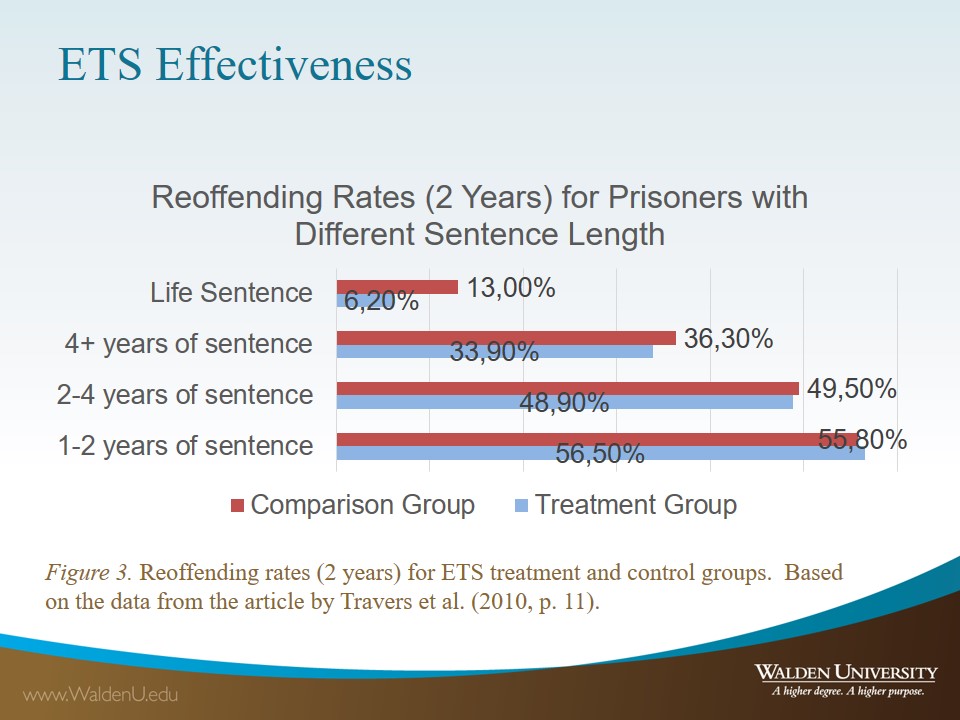
Alternative to ETS?
- Gobbett and Sellen (2013):
- New approach to ETS: Thinking Skills Programme (TSP).
- TSP shown to be more effective (psychometric assessments).
- But: very small sample; issues with statistical significance.
- Conclusion: more research needed.
A recent study by Gobbett and Sellen (2013) also compared ETS to its more modern version, which is termed the Thinking Skills Programme (TSP). Gobbett and Sellen (2013) show that the latter may be more effective since it has higher scores for all the measures that the authors employed, including, for example, impulsivity, entitlement, and so on. The authors chose not to consider reconviction data.
It can be suggested that the approach of Gobbett and Sellen (2013) has merit: it is important to consider the impact that a cognitive-behavioral program has on the participants’ thinking. However, the authors used a very small sample and made conclusions based on the differences in scores (not its statistical significance). Thus, more research in this regard is required.
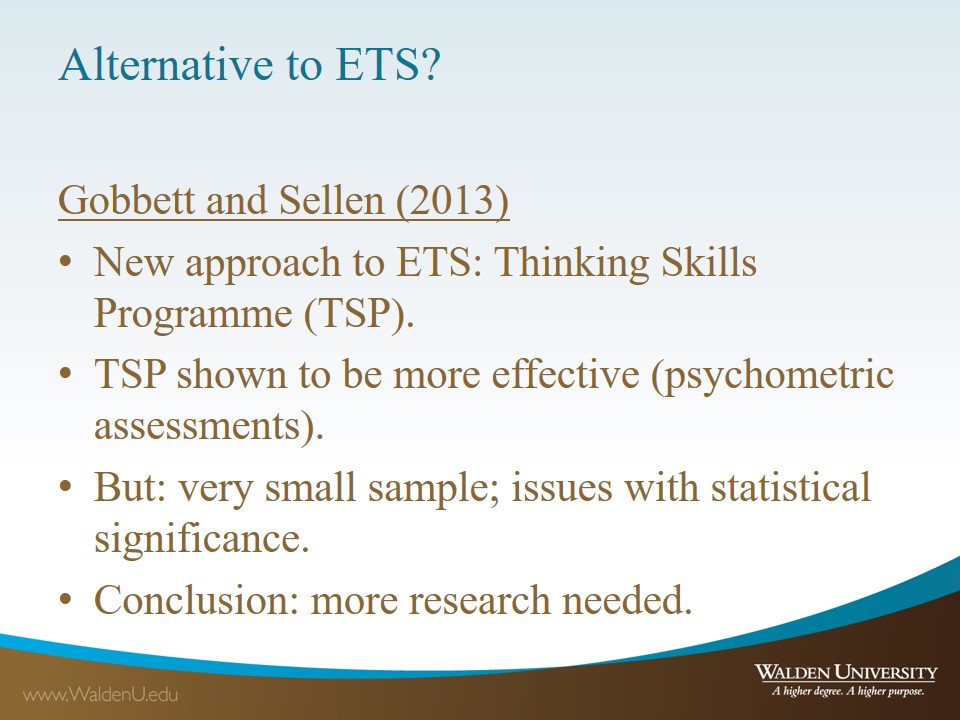
CTTC Effectiveness
There is less data on CTTS; the National Institute of Justice (2018a) identifies only one recent study that is worth noting. Barnes et al. (2016) examine the reoffending in 1,289 people, 457 of which were randomly placed in the intervention group. The sample was large, but the study followed the participants for only one year. The results indicated a statistically significant reduction in the prevalence of reoffending when all offenses were considered at once. However, the authors also presented the information for different types of offenses, in which case the significance was not present for any of them. No statistically significant effect on the frequency of reoffending was found (see fig. 4). It should be noted that the ETS studies did not consider various types of offenses individually. However, the changes in the frequency of reoffending for CTTC were not statistically significant, and, as a result, the National Institute of Justice (2018a) deemed CTTC not effective.
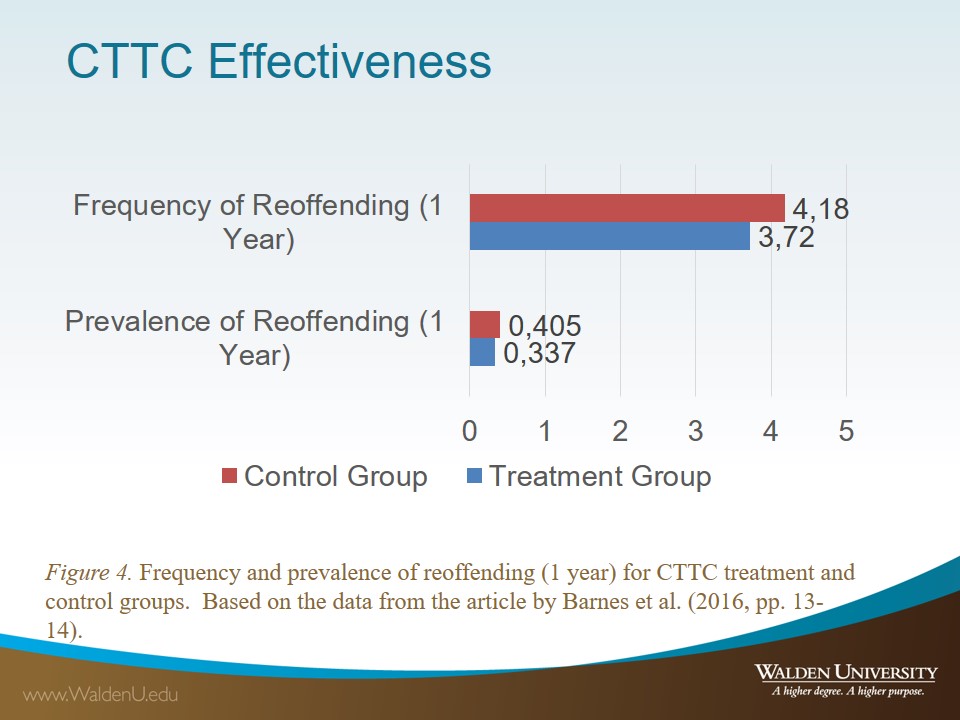
Comparison and Suggestions for Improvement
- Two similar programs; ETS => 3 supportive studies, and CTTC => one disproving study.
- Conclusion: ETS more effective than CTTC (National Institute of Justice, 2018b).
Potential improvements:
- CTTC: review of the methods.
- Both: delivery by professionals.
Thus, it is apparent that the two approaches would be expected to have different efficiency. ETS is supported by at least three studies. CTTC has only one randomized controlled trial dedicated to it, and the latter suggests that CTTC is not effective. The National Institute of Justice (2018b) indicates that the data from high-quality research can be used to define the effectiveness of a reentry program. Also, the programs are mostly similar: they use CBT-based methods to provide high-risk offenders with the skills required for reentry. Thus, it can be suggested that the programs can be compared, and the comparison would be in favor of ETS as shown by the presented statistical analyses of reoffending and reconviction.
However, as pointed out by Gobbett and Sellen (2013), reentry programs may benefit from some improvements. First, it is apparent that CTTC requires the revision of its content and methods since it is not effective in its current form. However, it is more important to note that, as it has been mentioned, both programs are delivered by prison staff. Barnes et al. (2016) demonstrate that the people who are assigned to this task typically lack relevant training. The possibility of delivering programs by professionals or training staff for this activity seems to be a feasible and important improvement strategy. Thus, the introduction of professional delivery is the one revision that should be suggested for both programs.

Conclusions
- Statistical analyses of outcomes: ETS more effective than CTTC?
- Lack of research (more needed):
- Only specific metrics (most often, reoffending).
- Few studies; some outdated.
- Potential improvements: professional delivery.
In summary, the ETS has been shown to be more effective than CTTC. This conclusion is based on the statistical analysis of the rates of reoffending and reconviction. However, it should be noted that both programs are understudied. They require more attention from researchers for conclusive statements to be made because the number of studies dedicated to them is small, and some of them are outdated. Additionally, the literature that does exist seems to focus on specific metrics, which illustrate the programs’ effectiveness but do not reflect it fully. For example, the investigation of the psychometric parameters can be considered. Finally, both ETS and CTTC can be improved through the introduction of professional delivery, which the key suggestion for their revision that can be proposed.
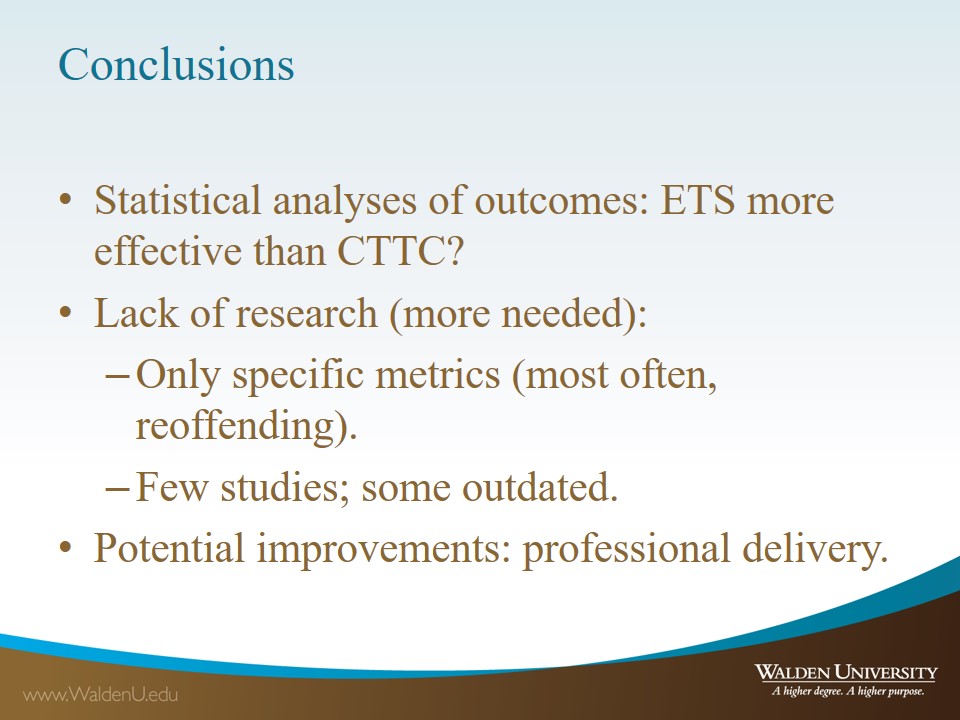
References
Barnes, G., Hyatt, J., & Sherman, L. (2016). Even a little bit helps. Criminal Justice And Behavior, 44(4), 611-630. Web.
Gobbett, M., & Sellen, J. (2013). An evaluation of the HM Prison Service “Thinking Skills Programme” using psychometric assessments. International Journal Of Offender Therapy And Comparative Criminology, 58(4), 454-473. Web.
National Institute of Justice. (2017). Program profile: Enhanced Thinking Skills (England). Web.
National Institute of Justice. (2018a). Program profile: Choosing to Think, Thinking to Choose. Web.
National Institute of Justice. (2018b). Research on returning offender programs and promising practices. Web.
Sadlier, G. (2010). Evaluation of the impact of the HM Prison Service Enhanced Thinking Skills programme on reoffending outcomes of the surveying prisoner crime reduction (SPCR) sample. Web.
Travers, R., Wakeling, H. C., Mann, R. E., & Hollin, C. R. (2013). Reconviction following a cognitive skills intervention: An alternative quasi‐experimental methodology. Legal and Criminological Psychology, 18(1), 48-65. Web.